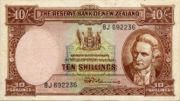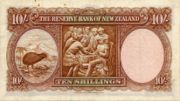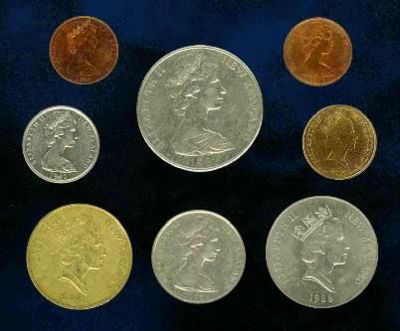紐西蘭元
出自 MBA智库百科(https://wiki.mbalib.com/)
紐西蘭元(New Zealand Dollar 原符號:$NZ. 標準符號:NZD)
目錄 |
紐西蘭元(貨幣代碼:NZD)是紐西蘭、庫克群島、紐埃、托克勞及皮特凱恩群島的法定貨幣,於1967年起使用。通常簡稱為$、NZ$或紐元,英語俗稱Kiwi。一紐元可分為100紐西蘭仙。
紐西蘭元代替原本是紐西蘭法定貨幣的紐西蘭鎊。2006年7月31日,紐西蘭儲備銀行引入新硬幣,取消5仙硬幣的流通地位,並以較細小的新硬幣取代沿用的1毫,2毫及5毫硬幣;而1元及2元則繼續使用。
紐西蘭元,由紐西蘭中央銀行——紐西蘭儲備銀行發行。
在1840年之前,紐西蘭市場流通的貨幣主要是英國的硬幣,此外還有法國、荷蘭等國的硬幣。紙幣很少,一般是由私營銀行發行,用途只限於大額的支付。 1840 年紐西蘭首任總督根據1816年“英國皇家鑄市法”宣佈當時在紐西蘭流通的所有硬幣為合法貨幣,包括各種用黃金、白銀和青銅製造的硬幣。1870年紐西蘭實施“皇家鑄市法”,使皇家鑄幣成為官方貨幣。這一時期紙幣的使用增加了。有六家銀行各自發行自己的銀行券,這些銀行券的規格和圖案都不一樣,互相兌換也很困難。到 1924年,這些銀行統一了銀行券的規格和顏色,但仍不能互相兌換。1934年紐西蘭建立了儲備銀行,行使中央銀行職責,開始發行統一的鈔票。鈔票面額為1鎊、5鎊和50鎊,實行20進位制。1961年紐西蘭加入國際貨幣基金組織後規定紐西蘭鎊含金量為2.47130克。1967年發行十進位的新貨幣紐西蘭元,含金量1.23565克,與英鎊掛鉤。1971年美元實行浮動匯率後,紐西蘭元改盯美元。1973年當美元再次貶值時,紐西蘭政府宣佈放棄紐西蘭元與美元聯繫,實行有管理的自由浮動,其有效匯率值由該國主要貿易伙伴的一攬子貨幣決定。1983年8月,紐西蘭儲備銀行廢除每日制定美元匯率的做法,允許紐西蘭元隨國際金融市場上的行情變化而波動。1984 年底,取消幾乎所有的外匯管制。1985年,紐西蘭採取伸縮性匯率制度,紐西蘭儲備銀行停止報出紐西蘭元的官方買賣價,但允許中央銀行在市場失去秩序時干預市場,同時終止了與一攬子貿易加權貨幣掛鉤。
現流通的紙幣有:1、2、5、10、20、50、100元等面額
現流通的鑄幣有:1、2、5、 10、20、50分及1、2元。
1紐西蘭元等於100分(Cents)
The New Zealand Pound (1840 - 1967)
The pound was the currency of New Zealand between 1840 and 1967. Like the British pound, it was subdivided into 240 pennies or 20 shillings. 1 shilling = 12 pence. The currency was part of the sterling zone. It was replaced in 1967 by the dollar at a rate of 2 dollars = 1 pound (1 dollar = 10 shillings).
Written and Verbal Conventions
In writing, there were several conventions for representing amounts of money in pounds, shillings and pence:
£2.3s.6d. (two pounds, three shillings and six pence)
1/- (one shilling) (slang: a bob)
11d. (eleven pence)
1½d (a penny halfpenny, three halfpence – note that the "lf" in halfpenny/halfpence was always silent - they were pronounced 'haypenny' and 'haypence' - hence the occasional spellings "ha'penny" and "ha'pence")
2/6 (two shillings and six pence, usually pronounced as "two-and-six" or "half a crown")
2/- (two shillings, or one florin) (two bob)
4s.3d. ("four-and-threepence")
5s. (five shillings) (one crown) (five bob)
14-8-2 (fourteen pounds, eight shillings and tuppence – in columns of figures, such as in a ledger)
£1.10s.- (one pound, ten shillings) (thirty bob)
Halfpennies and farthings (quarter of a penny) were represented by the appropriate symbol after the whole pence.
A convention frequently used in retail pricing was to list prices over one pound all in shillings, rather than in pounds and shillings; for example, £4-18-0 would be written as 98/-.
The New Zealand Pre-decimal Coins
Intitally, British and Australian coins circulated in New Zealand. Distinct coins were introduced in 1933 in denominations of 3 and 6 pence, 1 shilling, 1 florin (2 shillings) and ½ crown (2½ shillings). All were minted in silver until 1947. In 1940, bronze ½ and 1 penny coins were introduced. All denominations were issued until 1965.
Commemorative crowns (5 shillings) were minted in 1935, 1949 and 1953 for the Treaty of Waitangi, a royal visit and the coronation of Queen Elizabeth II, respectively.
Designs of New Zealand Pre-decimal Coins
| DENOMINATION | DESIGN |
|---|---|
| 1/2d (Halfpenny) | Maori Carving |
| 1d (Penny) | Tui Bird |
| 3d (Threepence) | Two carved patu (Maori weapons) |
| 6d (Sixpence) | Huia (an extinct New Zealand bird) |
| 1/- (Shilling) | Maori warrior holding a taiaha (weapon) |
| 2/- (Florin) | Kiwi Bird |
| 2/6 (Half Crown) | New Zealand Coat of Arms |
The New Zealand Pre-decimal Banknotes
Private trading banks originally issued all banknotes in New Zealand. The first bank notes were issued in New Zealand in 1840 by the Union Bank of Australia. In 1934 the Government of New Zealand passed the Reserve Bank Act which created the Reserve Bank of New Zealand. By virtue of the Act the Reserve Bank was given the sole right to issue New Zealand legal tender banknotes and coins.
The Reserve Bank of New Zealand introduced notes in 1934 for 10 shillings, 1, 5 and 50 pounds. In 1940, 10 pound notes were added. Only two series of notes were printed, the first (1934-40) featured the portrait of a Māori king, the second (1940-67) featured Captain James Cook.
The New Zealand Dollar (1967 - present)
In 1967, when the country decimalized its currency, the dollar replaced the New Zealand pound at a rate of 2 dollars = 1 pound. Like other dollar denominated currencies, the dollar sign "$" is used to express prices in New Zealand dollars, sometimes prices are written using NZ$ to distinguish it from other dollar currencies. The New Zealand dollar's ISO 4217 code is NZD. The value of the New Zealand dollar was initially pegged to the US dollar at a rate of US$1.39 = NZ$1. This rate changed on 21 November 1967 to US$1.12 = NZ$1 after the devaluation of the British pound, although the New Zealand dollar was devalued to a greater extent than the British pound sterling.
In 1971, the U.S.A. devalued its dollar relative to gold, leading New Zealand to peg its dollar at a value of US$1.216 with a 4.5% fluctuation range on 23 December (keeping the same gold value). From 9 July 1973 to 4 March 1985 the dollar's value was determined from a trade-weighted basket of currencies. Since 4 March 1985 the dollar's value has been determined by the financial markets, and has been in the range of about 0.39–0.74 United States dollars. The dollar's most recent minimum average daily value was 0.3922 U.S. dollars on 22 November 2000, and its most recent maximum was 0.7442 U.S. dollars on 17 March 2005. Much of this medium-term variation in the exchange rate has been attributed to differences in interest rates.
New Zealand Decimal Coins
In 1967, coins were introduced for 1, 2, 5, 10, 20 and 50 cents. The 1 and 2 cent coins were minted in bronze, with the other denominations in cupro-nickel. The 5, 10 and 20 cents were the same size as the earlier, equivalent 6 pence, 1 shilling and 1 florin. Indeed, until 1970, the 10 cents coin bore the additional legend "One Shilling". The obverse designs of all the coins featured Arnold Machin's portrait of Elizabeth II, with the legend ELIZABETH II NEW ZEALAND [date]. The reverse sides of coins introduced in 1967 did not follow the designs that were originally indended for them. Those modern art and sculpture themed designs were leaked to a newspaper and met a very negative public reaction. The final releases were given more conservative designs in line with public expectations.
In 1986, New Zealand adopted Raphael Maklouf's new portrait of the Queen on all its coins. The 1 and 2 cent coins were last minted for circulation in 1987, with collector coins being made for 1988. The coins were demonetised on 1 May 1990. The lack of 1 and 2 cent coins meant that cash transactions were normally rounded to the nearest 5 cents (10 cents as of 2006), a process known as Swedish rounding. Some larger retailers (notably one supermarket chain), in the interests of public relations, elected to round the total price down (so that $4.99 became $4.95 instead of $5.00). Alternatively, many retailers rounded all their prices to the nearest 5 cents to avoid the issue entirely, so a New Zealand shopper often encountered products for sale at prices like $4.95.
In 1990, aluminium-bronze 1 and 2 dollar coins were introduced to replace existing $1 and $2 notes. In 1999, Ian Rank-Broadley's portrait of the Queen was introduced and the legend rearranged to read NEW ZEALAND ELIZABETH II [date].
On 11 November 2004, the Reserve Bank announced that it proposed to take the 5¢ coin out of circulation and to make the existing 50, 20 and 10 cent coins smaller and use plated steel to make them lighter. After a three-month public submission period that ended on 4 February 2005, the Reserve Bank announced on 31 March it would go ahead with the proposed changes. The changeover period started on 31 July 2006, with the old coins usable up until 31 October 2006. The older 50, 20, 10 and 5 cent pieces are now no longer legal tender, but are still redeemable at the Reserve Bank.
New Zealand Dollar Banknotes
In 1967, notes were introduced by the Reserve Bank of New Zealand in denominations of 1, 2, 5, 10, 20 and 100 dollars. 50 dollar notes were added in 1983, whilst 1 and 2 dollar notes were discontinued in 1991. The first two series of notes (1967-81 and 1981-92) differed only in the portait of the Queen featured on the obverse. The reverses all depicted native birds and plants and remained unchanged through both series.
In 1992 A completely redesigned new series of banknotes was introduced by the Reserve Bank of New Zealand and except for the 20 dollars, the portrait of the Queen was dropped from all notes.
New Zealand banknotes, since 1999, have been printed on plastic polymer instead of conventional rag paper used for banknote production. There was a slight controversy, but this move was mostly met with curiosity by the public. Such polymer notes have many advantages, notably a photocopy can effortlessly be distinguished from the real thing by touch, and many people have been thankful that the notes go through a washing machine with no ill effects. The notes are also difficult to tear without the aid of a cutting tool, but will tear more easily than the paper notes if a tear is started. Initial versions of the polymer $5 note had issues with the ink wearing and aging prematurely, but this was rectified in later production runs. The Reserve Bank states that polymer banknotes last at least four times as long as the old conventional paper banknotes. The polymer banknotes also have vastly improved security features and are very difficult to counterfeit.
- Reserve Bank of New Zealand - Pre-decimal Currency (1934 - 1967)
- 1 New Zealand Pound = 20 Shillings = 240 Pence
- Reserve Bank of New Zealand - Decimal Currency (1967 - Present)
- 2 New Zealand Dollars = 1 New Zealand Pound
- 1 New Zealand Dollar = 100 Cents
































































